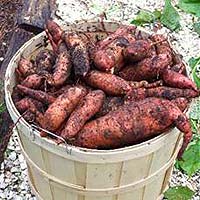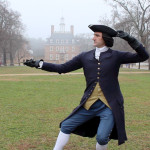 Gardeners are harvesting the last of the sweet potatoes from several kitchen gardens in the Historic Area. According to Colonial Willliamsburg garden historian Wesley Greene, the use of the sweet potato (Ipomoea batatas) in Virginia predates the use of the white potato by about one hundred years.
Gardeners are harvesting the last of the sweet potatoes from several kitchen gardens in the Historic Area. According to Colonial Willliamsburg garden historian Wesley Greene, the use of the sweet potato (Ipomoea batatas) in Virginia predates the use of the white potato by about one hundred years.
English author Philip Miller wrote in his book The Gardeners Dictionary (1754) that the sweet potato was cultivated in Spain and Portugal and shipped to England. Miller writes that sweet potatoes “… are by some Persons greatly esteemed; tho’ in general they are not so well liked as the common Potato, being too sweet and luscious for most Palates.”
Whereas Miller describes their taste, Robert Beverly, a substantial planter and colonial official in Virginia describes what they look like in his book, The History and Present State of Virginia, (1705) saying, “Their [the Natives] Potatoes are either red or white, about as long as a Boy’s Leg, and sometimes as long and big as both the Leg and Thigh of a young Child, and very much resembling it in Shape.” Even though Colonial Williamsburg’s well-manured vegetable plots produce large sweet potatoes, they have not yet reached the size of a boy’s leg.
Another crop being harvested in our gardens now, unfortunately more by the squirrels than the gardeners, is the bull nose pepper. The three most common peppers in the colonies seem to have been the cayenne, tomato, and the bell or bull nose pepper. The bull nose pepper was grown at Monticello by Thomas Jefferson. It has been described as one of the best pickled peppers because of its mildness and thick rind. As the pepper matures from green to scarlet it becomes sweeter.
Wesley believes that although the bull nose pepper is the best representative we have today of the old bell peppers, it is probably larger than the original bell pepper. Wesley’s research indicates that although bell peppers are appropriate for the 18th century, we should grow them in only a few of our gardens, primarily at the homes of experimental gardeners or perhaps slave dwellings. Hopefully the squirrels will let us do so.


Leave a Reply